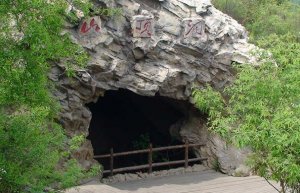英语听力文摘 English Digest 413、偶尔的“山顶洞人”(在线收听)
Sometime Cavemen
偶尔的山顶洞人
From the bestselling novel “Clan of the Cave Bear” to the 1981 movie “Caveman“, pop-culture tends to misrepresent prehistoric people as cave dwelling brutes. But even the most speculative recreations of early human society are based on a few essential facts. For instance, cavemen made their homes in caves, right?
Well, not exactly. According to archeological evidence, prehistoric human ancestors such as Homo habilis, Homo erectus, and Homo ergaster were nomadic rather than settle in one place for long periods of time, they were constantly on the move in search of food and shelter. In other words, the term “caveman” is a bit misleading, since our stone age ancestors did not set up permanent homes in caves.
Then why are prehistoric people so often referred to as cavemen? There are several reasons. First, much evidence of prehistoric civilization is found in caves because the natural shelter helps preserve artifacts.
The earliest cave dwellers date to the Paleolithic period, around 2.5 million years ago, and evidence suggests that these ancient nomads used caves as temporary shelters during their seasonal wanderings. The caves often lay on valley slopes and provided excellent views of animal migration routes.
But there is no evidence that Stone Age peoples set up shop in caves for very long. Even Neanderthals, who lived in relatively cold regions of ancient Europe, used caves only for temporary shelter.
Our more immediate ancestors did, of course, eventually move indoors. But permanent dwellings came about only with the invention of agriculture and animal husbandry. Before those world-changing inventions, prehistoric people were forced to follow their food away from the warmth and shelter of the cave.
从畅销小说《洞熊家族》到1981年的电影“山洞人”,流行文化在趋于误将史前时期的人看做是穴居的动物。然而即便是在早期人类社会,投机娱乐也是基于一些重要的事实。例如,山顶洞人是自己将家安在山洞里的,对吧?
然而,也不完全是这样。根据考古证据,史前的人类祖先,比如说巧手人、直立人以及东非直立人,他们都是游牧的,而并非是在一个地方定居很长一段时间,他们一直都在迁移,以求寻找食物和居所。换句话说,“山洞人”这一说法有一点误导人们。因为我们石器时代的祖先并没有在洞穴建立永久的住所。
然而为何史前时期的人通常都被看成是山顶洞人?有几个方面的原因。首先,由于洞穴这个天然避难所就有助于保护物件,所以很多有关史前文明的证据都是在洞穴中发现的,
最早的穴居者可以追索到大约250万年前的旧石器时代,有证据显示这些远古的游牧民在他们季节性迁移的时候有将洞穴作为临时居住地。这些洞穴通常都是位于山谷的斜坡,它是个观察动物移动路线的绝佳地方。
但是,并没有证据表明石器时代的人有长时间在洞穴中建立商店。即使是在古欧洲居住在相对来说较冷地区的尼安德特人,他们也只是将洞穴当作短暂的居住地。
当然,与我们更接近的祖先最终还是搬进了室内。但是直到农业和畜牧业出现后人们才形成永久的住所。在这些改变世界的发明出现之前,史前时期的人类被迫要远离温暖的避难所——洞穴,去寻找食物。


